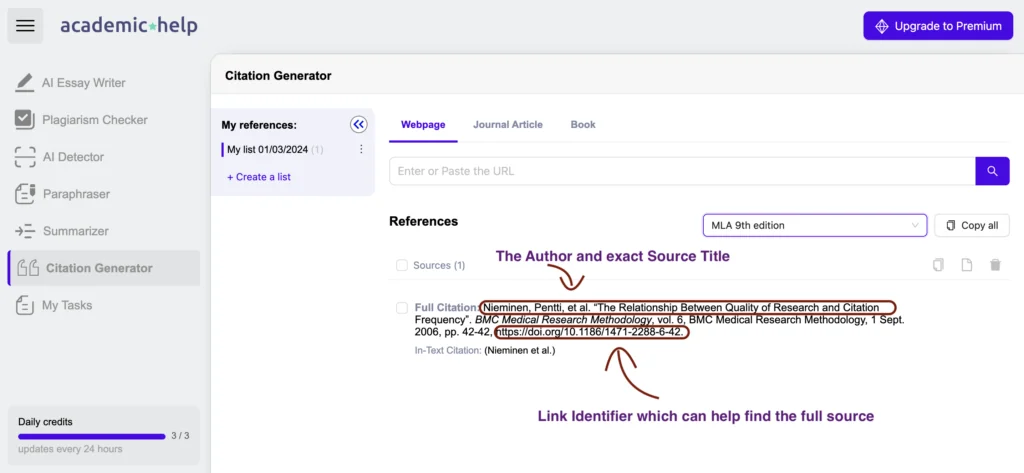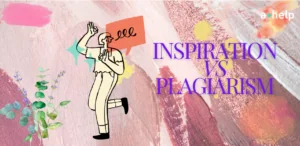You are writing an assignment, be it an essay, literature analysis, research overview, or a thesis. You include some details from outside sources. You quote that information and include an in-text citation. So, is it plagiarism then, if you cited it? The short answer is no. Nonetheless, there are some nuances to this. So keep reading on if you want to learn more about plagiarism prevention.

✅ AI Essay Writer ✅ AI Detector ✅ Plagchecker ✅ Paraphraser
✅ Summarizer ✅ Citation Generator
Citing In-Text and in the Reference List
Okay, first, let’s figure out together why would you think that cited work can be considered plagiarism. If you plagiarism something, this means that you take information from some source outside, don’t mention that you’ve taken it, and just leave it in your work as if those ideas were your own. Thus, if you have mentioned the source/author you took the details from, then it already can’t be considered plagiarism.
In case anybody told you otherwise – don’t believe them. However, note, that it’s not enough to just include in-text citations. Yes, it may keep you in the clear, but for scientific works it is always necessary to add a list of references as well. With the help of a properly formatted reference entry, you show which work precisely was used and where you found it (e.g. in an online library). Below we include an example of a well-structured citation on the reference list made by AHelp Citation Generator.

Will Citations Keep You From Plagiarizing?
Yet, you should note, that if you inserted a citation once in your text it doesn’t mean your work won’t have any plagiarism. While proper citation is necessary to avoid plagiarism, it is not sufficient on its own.
Let’s imagine you have taken a paragraph from the work we cited on the picture above. For example, you’ve used these results to support the claims in your paper:
“A total of 448 research papers were included in the citation analysis. Unclear or inadequate reporting of the research question and primary outcome were not statistically significantly associated with the citation counts. After adjusting for the journal, an extended description of statistical procedures had a positive effect on the number of citations received. Inappropriate statistical analysis did not affect the number of citations received. Adequate reporting of the primary research question, statistical methods and primary findings were all associated with the journal visibility and prestige.” (Nieminen et al. 1)
As you can see, we put the paragraph in quotation marks and added the MLA 9th in-text citation. So now, we have it cited both in-text and on the reference list. You would think that now you are free from plagiarism and have all the right to re-use this information. After all, you’ve mentioned the original author and source, right? However, if you continue to refer to these details further in your work, you will hjave to continuosly add the citation for it as well.
There can also be another case: when you add too many quotes and not enough of your own insights and analysis. We will discuss this balance in the paragraph below, but just so you know, such cituations may also lead you to plagiarism accusations. Thus, you have to use citations sensibly, focusing on the most critical parts of the source and ensuring that your voice and ideas remain dominant.
Additionally, paraphrasing or summarizing without citation, even if the words are your own, constitutes plagiarism too. All it takes to avoid unintentional plagiarism, is to understand and follow proper citation and paraphrasing practices and ask for guidance (from your academic advisors, peers, or online) when in doubt.
The Balance Between Original Work and Quoted Material
As we promised, we will now talk about the balance between quoted material and original content in your work. You see, any research paper or even literature analysis has to provide some kind of value to the filed you are working in. For this reason, simply bringing all the different ideas from various sources is not enough. You have to show what YOU have taken from all of this.

Over-reliance on quotes can overshadow your own ideas and voice, making your work seem more like a compilation of others’ thoughts rather than a coherent piece with your unique perspective. Generally, the acceppted threshhold for quoted material is around 20%-30% of the overall writing. This proportion allows you to provide necessary support and evidence from external sources while still allowing you to include your own analysis and interpretation at the forefront.
Based on this, we reccomd you to consider the following when putting your work together:
- When incorporating quotes, focus on the most impactful and relevant segments that directly support your argument or analysis (no need to cite whole paragraphs, as we did in our example).
- Avoid long blocks of quoted text. Instead, use shorter excerpts and integrate them seamlessly into your narrative.
- Provide your interpretation, explanation, or analysis of each quote, demonstrating its relevance to your argument and how it supports and enhances the overall message of your work.
Quotes aren’t the main heroes in your writing – your thoughts are. Hence, if you decide to quote somnething, you should think about how adding this nformation will compliment your work and help you drive the analysis and research forward.
The Gray Areas of Plagiarism
Plagiarism is not always black and white. And the gray areas are precisely the ones that lead to unintentional violations. We already mentioned the scenario where you reuse a sentence/paragraph with a citation. While it may seem that citing the source saves one from plagiarism, this is not always the case. For example, copying a paragraph verbatim from a source and simply adding a citation at the end isn’t a proper use of the material. This practice can still be considered plagiarism because it does not demonstrate original thought or interpretation (which, as we pointed out, is crusial in any paper).
To avoid this type of plagiarism, you can integrate the material into your own sentence structure. In other case, you can also use your paraphrasing skills. By rephrasing the ideas from your sources in your own words and maintaining the original meaning, you can avoid the pitfall of over-reliance on direct quotes. Remember though, paraphrasing still requires both a citation and a refrence entry, as the ideas are not your own.
FAQ
Follow us on Reddit for more insights and updates.





Comments (0)
Welcome to A*Help comments!
We’re all about debate and discussion at A*Help.
We value the diverse opinions of users, so you may find points of view that you don’t agree with. And that’s cool. However, there are certain things we’re not OK with: attempts to manipulate our data in any way, for example, or the posting of discriminative, offensive, hateful, or disparaging material.